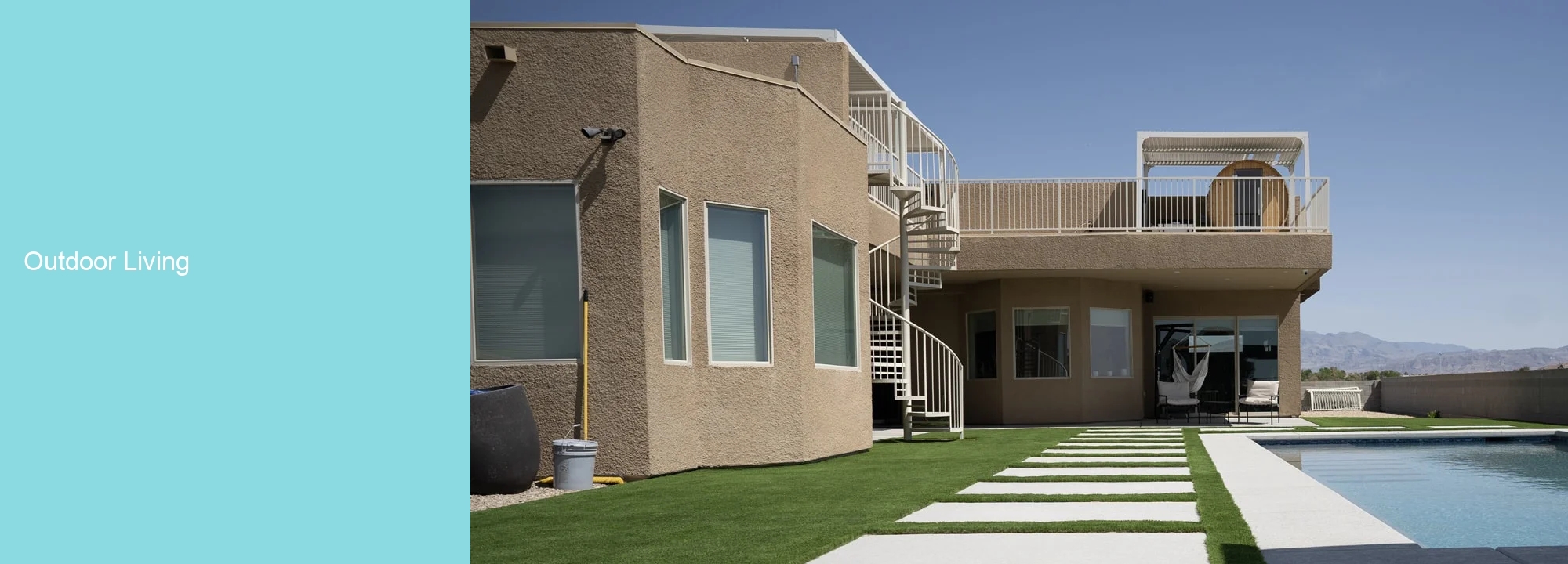

The first step in designing an outdoor living space is understanding the purpose it will serve. Will it be a tranquil oasis for relaxation, or a vibrant hub for entertaining? Knowing how you intend to use the space will guide your decisions on which elements to include, from seating arrangements to lighting fixtures.
Selecting furniture that complements your outdoor environment is crucial. Ideal choices are not only aesthetically pleasing but also durable enough to withstand weather conditions. Consider pieces that blend functionality with comfort, like all-weather sofas or hammocks.
Integrating natural elements can enhance the overall ambiance of your outdoor space. This often involves landscaping with flowers, shrubbery, or even trees. You might consider incorporating water features such as fountains or ponds and using materials like wood or stone to give a rustic feel.
Good lighting can transform your outdoor living area from ordinary to magical. For evening usage, think about solar-powered lanterns, string lights, or pathway lights for safety. In addition to providing illumination, these light sources can contribute significantly to the mood and aesthetics of the space.
Lastly, infuse your personality into the design through personal touches. These could range from unique garden decorations and colorful cushions to an outdoor barbeque station or fire pit for gatherings. Regardless of what you choose, ensure it reflects your style and creates a welcoming atmosphere.
Before deciding on your outdoor furniture, it's crucial to understand the specifics of your outdoor area. The size, shape, and purpose of the space will greatly influence the type of furniture you should buy. For instance, if you have a small balcony, multi-functional pieces like storage benches would be ideal. If you have a large patio meant for entertaining, consider larger items such as an outdoor dining set or a sectional sofa.
The materials used in your outdoor furniture are pivotal in determining their durability and longevity. Opt for weather-resistant materials that can withstand varying climatic conditions. Wood like teak and eucalyptus is popular for its natural resistance to moisture and insects. Metals like aluminum are beneficial for their lightness and rust-resistance whereas synthetic resin provides excellent weather resistance with a more traditional wicker look.
While functionality is key in choosing outdoor furniture, comfort and style should not be overlooked. Choose furniture that reflects your personal aesthetic and complements the overall design of your house. Additionally, ensure that the pieces are comfortable enough for prolonged use - after all, the goal is to create an inviting space where you can relax or entertain guests.
Lastly, consider how much time you're willing to spend on maintenance when selecting outdoor furniture. Some materials require more upkeep than others; wood may need regular oiling or staining while metal might require repainting over time. Opting for low-maintenance materials like synthetic resin or aluminum could save you time and effort in the long run.
Creating a perfect outdoor ambiance involves meticulous planning and creative landscaping ideas. From choosing the right plants and flowers to selecting stylish yet functional outdoor furniture, every aspect plays a significant role in enhancing your backyard's aesthetic appeal. One popular idea is creating a focal point with a pergola or an elaborately designed flower bed around which other elements of your garden can be arranged. Use lighting strategically to highlight certain areas and create a mood during dusk and night hours. Water features such as fountains or koi ponds not only add visual interest but also contribute to a calming atmosphere. Remember, the key to achieving an ideal outdoor living space lies in balancing beauty and functionality while crafting your personal oasis.
Regular Cleaning: An essential aspect of maintaining outdoor spaces is regular cleaning. Remove leaves, dirt, and other debris that might accumulate over time. Pressure washing your patio or deck can also be beneficial for removing stubborn dirt and grime.
Furniture Maintenance: Your outdoor furniture endures all weather conditions and requires special care to maintain its appearance. Regularly clean it with suitable products depending on the material. For instance, wooden furniture may need re-staining or sealing to protect it from moisture damage.
Landscaping: Enhance the beauty of your outdoor living space through strategic landscaping. Plant colorful flowers, lush green plants, or even fruit trees to create a vibrant environment. Regularly trim your lawn and prune any shrubs and trees for a neat look.
Lighting: Good lighting can transform an outdoor space into an inviting haven when the sun goes down. Incorporate solar lights along pathways, string lights in trees or above seating areas for a warm glow. You could also add lanterns or fire pits for a cozy atmosphere.
Seasonal Preparations: Depending on where you live, preparing your outdoor living area for different seasons is crucial. During colder months, consider using patio heaters or fire pits to keep the area comfortable. In warmer seasons, umbrellas or shade sails offer protection from harsh sun rays while letting you enjoy the outdoors.
The key elements of an outdoor living space typically include comfortable seating arrangements, a source of shade (like an umbrella or pergola), a grill or outdoor kitchen for cooking, and features like fire pits or heaters that let you use the area year-round. You might also consider other amenities such as a pool, hot tub, or garden.
There are many ways to enhance the comfort and visual appeal of your outdoor space. Consider adding plush cushions to your chairs, hanging string lights for warmth and ambiance, incorporating plants and flowers for natural beauty, using rugs to define different areas within the space, setting up speakers for music or entertainment systems for movie nights.
Durable materials that can withstand exposure to weather changes are ideal for outdoor furniture. This includes teak, eucalyptus, metal (aluminum or wrought iron), synthetic resin wicker, and thick plastic. Cushions should be covered in fabric designed to resist UV damage and mold growth.